 Alamy
Alamy
An exhibition at London's Garden Museum explores the crucial role that nature played in the lives and work of the Bloomsbury Group, the radical British creative collective.
When you think of the women of the Bloomsbury Group, gardens probably aren't the first thing that comes to mind. But as Gardening Bohemia: The Outdoor Women of Bloomsbury, an exhibition at London's Garden Museum, makes clear, gardens played a crucial role in the creative lives of writers Virginia Woolf and Vita Sackville-West, Woolf's artist sister Vanessa Bell, and arts patron Lady Ottoline Morrell. Though vastly different in scale and ambition, their gardens were all sanctuaries and experimental spaces, places where the women and their circles of friends and family were free to explore innovative, often radical ideas about creativity, life, and love.
“We can really see how their gardens influenced their work in very tangible ways and in more ephemeral ways,” says Claudia Tobin, the writer and scholar who curated the exhibition.
This connection is perhaps most evident in Charleston, the Sussex farmhouse where Vanessa Bell and her lover Duncan Grant took refuge in 1916 during the First World War.
It was bustling with family and friends, a sociable, collaborative hive of creativity.
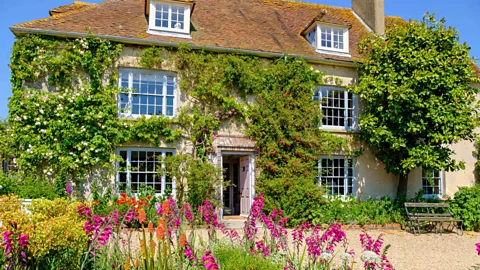 Alamy
Alamy
Vanessa Bell and Duncan Grant took refuge in Charleston, Sussex farmhouse during World War I (Photo courtesy of Alamy)
The garden's layout was designed by painter and critic Roger Fry, with its bold colors and simple abstract designs. Fry was inspired in part by Arts and Crafts garden designer Gertrude Jekyll, who had worked on his own gardens. “He took ideas from the Arts and Crafts movement and fused them with his own modernist vision,” explains Tobin.
It's all this exuberant decorative impulse – Claudia Tobin
Bell and Grant continued where Frye had started; their creative spirits spilled out into the garden and into their home. They loved bright colors and unusual shapes, especially the Red Hot Poker flower, which appears in many of their paintings. They made mosaic tiles to decorate the pond, as well as various sculptures that sit on the grounds. Having created such a delightful space, they frequently used it as an outdoor studio, or to select flowers and vegetables to feature in their still-life paintings. These natural elements are also prevalent throughout Charleston's unique interior design.
“You can see how these decorative motifs extend beyond the paintings into the walls, the tiles, the door panels — it's all this exuberant decorative impulse,” Tobin says.
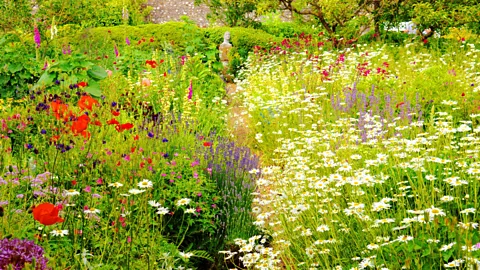 Getty Images
Getty Images
Charleston's gardens, featuring bold colors and abstract patterns, were designed by painter Roger Fry. (Photo: Getty Images)
The garden was also a safe place for Bell, Grant and their friends to explore unconventional views on life and love. Grant's lover, the writer David Garnett (both Bell and Grant were bisexual), was a regular visitor, as was Vanessa's husband, Clive Bell, with whom she was good friends. During the war, both Grant and Garnett were pacifists, and were able to work here as a farmer instead of going to the front.
“A living work of art”
Lady Ottoline Morrell's garden at Garsington Manor was slightly larger but equally vibrant and unconventional. The Morrells purchased the house in 1914, and Ottoline redesigned it, drawing inspiration from the gardens of Villa Capponi in Italy, which she had visited as a youth. In her memoirs, she describes the formal flower garden as “like a carpet of colour, sweetly scented”, and also describes “a monastery pond surrounded by Italian statues” and green paths “lined with peacocks fluttering their long tails”.
In this enchanting space, Morell gathered groups of artists, writers and intellectuals for long weekends of dancing, discussion, performance and bathing. Visitors included Katherine Mansfield, D. H. Lawrence and Aldous Huxley. She considered the gardens a kind of living work of art, and as a result they have inspired numerous literary and artistic interpretations, not all of which were complimentary.
 Alamy
Alamy
Lady Ottoline Morrell's vibrant garden at Garsington Manor was inspired by Italy's Villa Capponi (Credit: Alamy)
Huxley mercilessly lampooned Morell's eccentricities in his novel Chrome Yellow, but thankfully, Morell felt that Mansfield had a greater understanding of the aesthetic appeal of gardens: in their letters, Mansfield described his imaginary stories set in gardens as “musically like conversations set to flowers”.
“She brought people together, organized them into different collectives, and was a patron and supporter of artists in difficult situations,” Tobin says. Mark Gertler set up a studio there and painted the gardens, becoming a kind of artist-in-residence, but his somewhat sombre, empty paintings don't quite capture Garsington's hedonistic atmosphere.
The sense of liberation of the place is no more evident than in a photograph by artist Dora Carrington, who poses playfully next to the statue, completely nude. Carrington herself comments on the sense of freedom she felt when she walked with Mansfield into the moonlit gardens, this time fully clothed but wearing trousers, a highly unconventional outfit for women at the time.
[Nature] She needed it, especially during times of spiritual crisis, which sadly were many. – Claudia Tobin
Virginia Woolf's garden at Monk's House in Rodmell was a much more tranquil setting, a cherished sanctuary from the hustle and bustle of London, where she enjoyed “silent” weekends and undisturbed enjoyment of the garden's “tunnel of green”.
When Virginia and her husband Leonard purchased the house in 1919, it was still in fairly primitive condition, but she already had envisioned what it would become: “The highlight of this house is the garden… This will be the pride of our hearts,” she wrote enthusiastically to a friend.
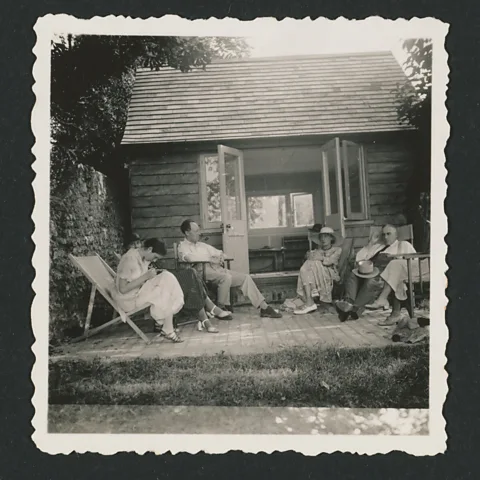 Harvard University Houghton Library
Harvard University Houghton Library
Angelica Garnett, Vanessa Bell, Clive Bell, Virginia Woolf, and John Maynard Keynes photographed in Monk's House Chapel in 1935 (Photo courtesy of Harvard University's Houghton Library)
Though Leonard was undoubtedly the more gardening-savvy of the two, Virginia enjoyed sharing the garden: They would happily work together in the flower beds into the evenings, leaving them “stiff and bruised” and with “chocolate-colored dirt under their fingernails,” she recalls. “I think that sense of intimacy and shared space was really important,” Tobin says.
“A beautiful escape”
Over the years, the gardens evolved to include an Italianate garden, a pond, a terrace, a bowling alley, and, of course, her own garden, “A Room of One's Own,” a writing shed set amongst the orchard where many of her most important novels and essays were written. Woolf went there every morning to write, and Tobin believes that her surroundings undoubtedly permeated her work.
“I think it indirectly influenced her novels, rather than literally describing flowers. But there's a sensory intensity to a lot of her writing about the natural world, particularly her most experimental novel, 'Waves.' There are some wonderful passages where she writes about the natural world from a child's point of view,” she says.
Tobin believes Woolf's engagement with nature was “therapeutic”. “She wrote about how she found her peace there, which she needed, especially during periods of spiritual crisis, which sadly were many,” she says.
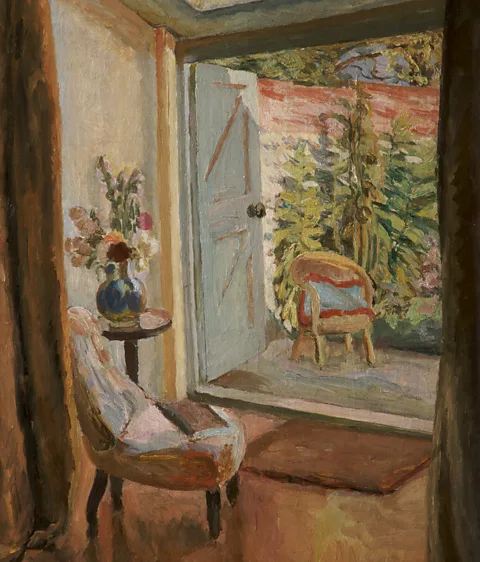 Bolton Council. From the collection of Bolton Library and Museum Service.
Bolton Council. From the collection of Bolton Library and Museum Service.
View of Vanessa Bell's garden, 1926 (Photo courtesy of Bolton City Council. From the collection of Bolton Library and Museum Service)
The importance of the garden to Woolf is evident from the fact that after her tragic suicide in 1941, her ashes were interred beneath one of a pair of elm trees, called Virginia and Leonard.
The gardens created by Woolf's lover, Vita Sackville-West, at Sissinghurst Castle are undoubtedly some of the most famous in England. Unlike Bell, Woolf and Morrell, Sackville-West was a novelist and poet as well as a skilled garden designer. Her combination of talent and sensibility resulted in a truly unique aesthetic.
“I feel like an artist painting a picture… adding a little color here, taking out a little there, until the overall composition is to my liking,” she writes.
Her “works” were a series of themed gardens – the Rose Garden, the Cottage Garden, the Herb Garden, the Spring Garden and, perhaps most famously, the White Garden – each conceived as a botanical “room” offering a stunningly beautiful escape from the mundane.
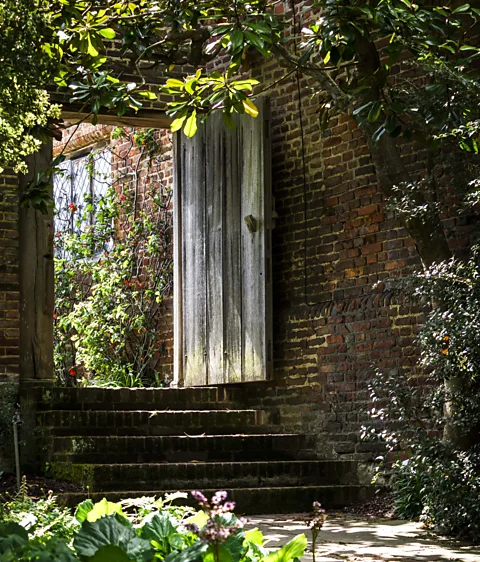 Getty Images
Getty Images
The gardens at Sissinghurst Castle, designed by Vita Sackville-West, are among the most famous in Britain (Photo: Getty Images)
“I think her romanticism and her sense of poetry combined with her sense of color was really distinctive,” Tobin says. “The combination of different poetic and cultural references creates something really special.”
Like Woolf, gardens also inspired Sackville-West's literary imagination: “For Vita, her work and the gardens were very symbiotic,” says Tobin. She was a very hands-on gardener, and the gardens themselves “feature often in her poetry and fiction, often as characters in their own right.”
This is particularly evident in her poems “Sissinghurst” and “The Garden”, the latter of which was published just after the Second World War and which Tobin considers “her survival poem, but one in which she lived through the garden; it is her own garden, but also the wider universal meaning of the garden”.
While Garsington Manor is now privately owned, the homes and gardens of Sissinghurst, Charleston and Monk's House are all open to the public, allowing us to follow in the footsteps of the Bloomsbury women, admire their enchanting vision and get a little inspiration of our own.



